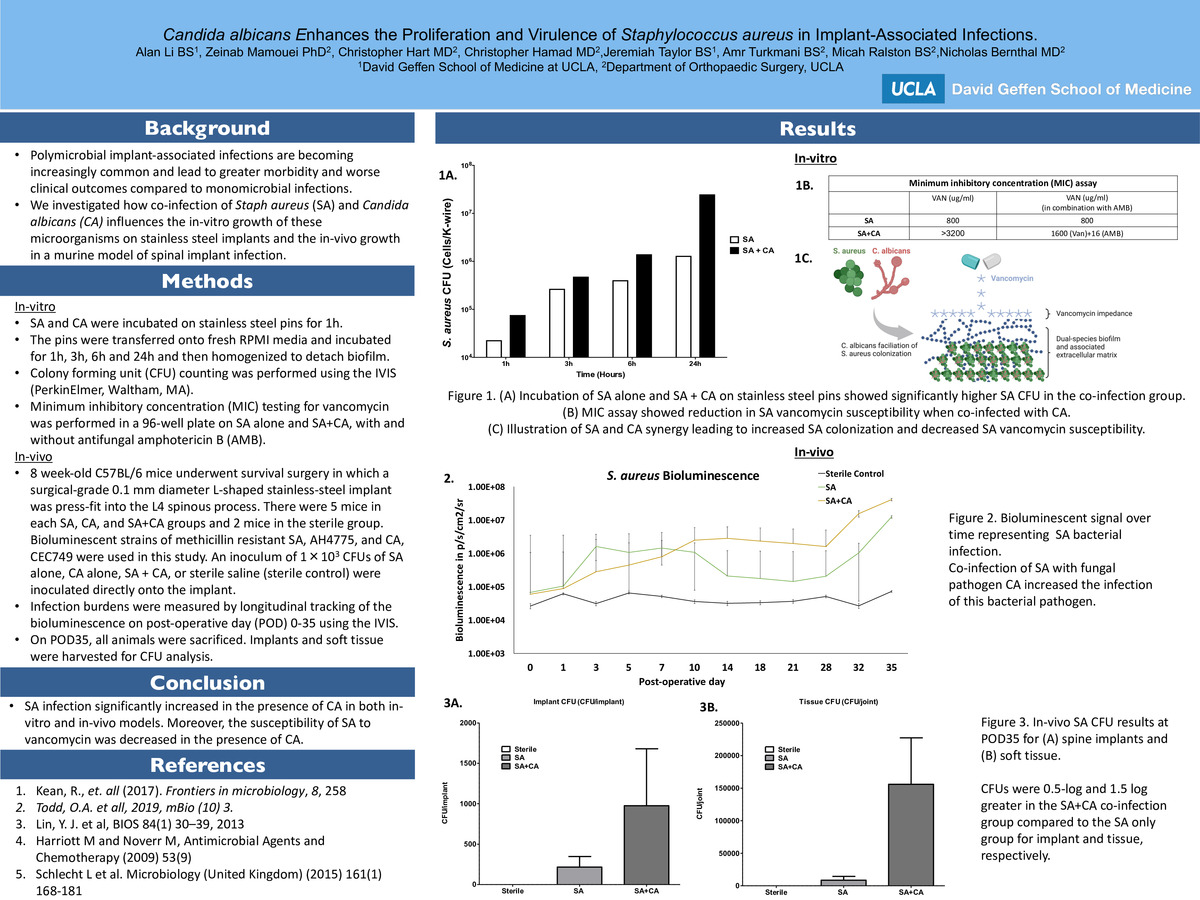-
Author
Alan Li -
PI
Dr. Nicholas Bernthal
-
Co-Author
Zeinab Mamouei PhD, Christopher Hart MD, Christopher Hamad MD,Jeremiah Taylor, Amr Turkmani, Micah Ralston
-
Title
Candida albicans Enhances the Proliferation and Virulence of Staphylococcus aureus in Implant-Associated Infections.
-
Program
CTSI TL1 Summer Program
-
Other Program (if not listed above)
-
Abstract
Background:
Polymicrobial implant-associated infections are becoming increasingly common and lead to greater morbidity and worse clinical outcomes compared to monomicrobial infections. However, the reasons underlying this difference are poorly understood, including what type of synergistic interactions exist between the most common bacterial and fungal pathogens Staphylococcus aureus (SA) and Candida albicans (CA). To address this gap, We investigated how co-infection of SA and CA influences the in-vitro growth of these microorganisms on stainless steel implants and the in-vivo growth in a murine model of spinal implant infection.
Methods:
SA and CA were incubated on stainless steel pins for 1h. The pins were subsequently transferred onto fresh RPMI media and incubated for 1h, 3h, 6h and 24h. The pins were homogenized to detach biofilm and Colony forming unit (CFU) counting was performed using the IVIS (PerkinElmer, Waltham, MA). Minimum inhibitory concentration (MIC) testing for vancomycin was performed in a 96-well plate on SA alone and SA+CA, with and without antifungal amphotericin B (AMB).
An in vivo mouse model of spinal implant infection was used to investigate the level of the microbial burden associated with monomicrobial versus polymicrobial infection. A bioluminescent MRSA strain of SA, AH4775, and a bioluminescent strain of CA, CEC749 were used in this study. Eight-week-old C57BL/6 mice underwent survival surgery in which a surgical-grade 0.1 mm diameter L-shaped stainless-steel implant was press-fit into the L4 spinous process. An inoculum of 1×103 CFUs of SA alone, CA alone, SA + CA, or sterile saline (sterile control) were inoculated directly onto the implant. There were 5 mice in each SA, CA, and SA+CA groups and 2 mice in the sterile control group. Bacterial and fungal burdens were measured by longitudinal tracking of the bioluminescence on POD 0, 1, 3, 5, 7, 10, 12, 14 using the IVIS (PerkinElmer, Waltham, MA).
Results:
Incubation of SA alone and SA + CA on stainless steel pins show significantly higher SA CFU in the co-infection group. Minimum inhibitory concentration (MIC) assay shows reduction in SA vancomycin susceptibility when co-infected with CA. The SA bacterial burden in the SA+CA group significantly increased after POD10 compared to the SA group (Figure 1-A).
Conclusion:
SA infection significantly increased in the presence of CA in both in-vitro and in-vivo models. Moreover, the susceptibility of SA to vancomycin was decreased in the presence of CA.
-
PDF
-
Zoom

